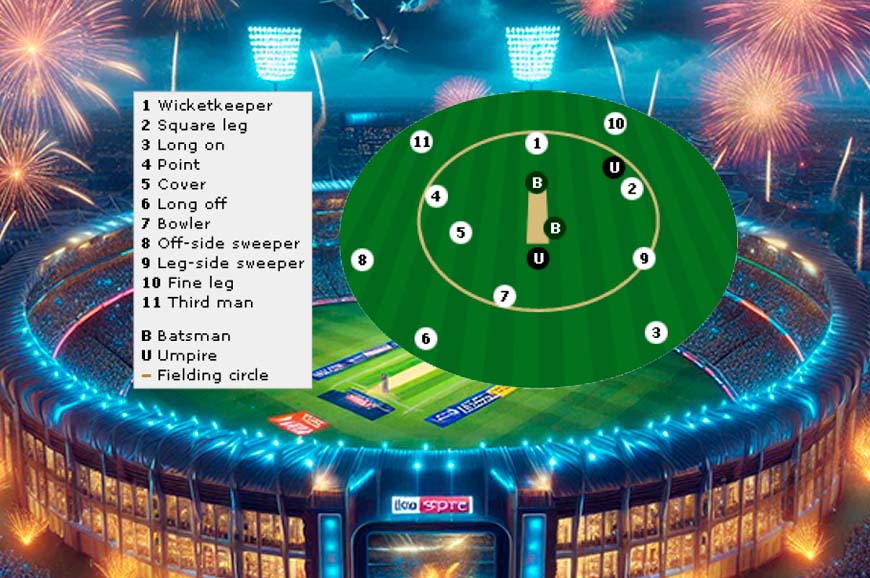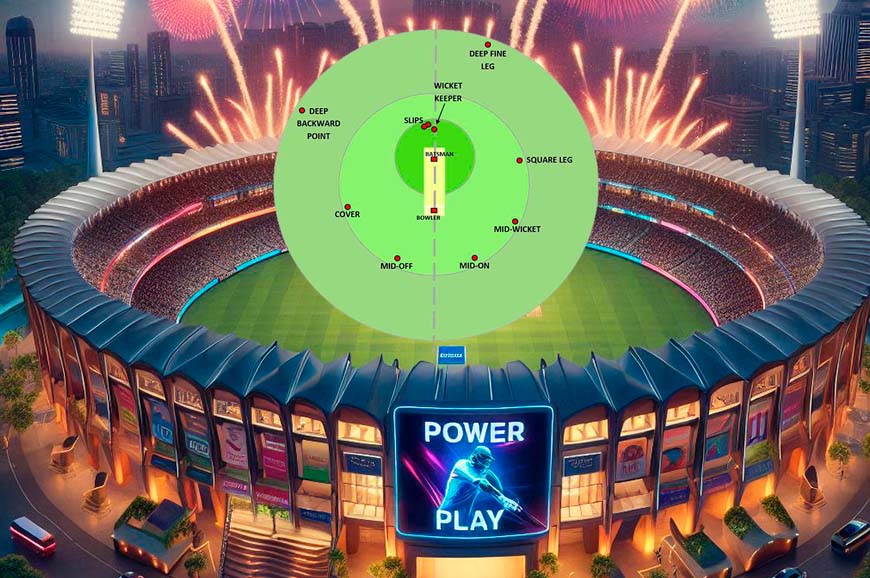Cricket has evolved a lot over the years, and so has batting in the power play. The sport was first played in the Test format, but then shorter formats were introduced, which had 60 overs per inning. This was further trimmed to 50.
Later, the T20I format started entertaining the audience in the 21st century. As the white-ball game evolved and batting in the shorter formats became more specialised, the restrictions became a crucial part of the sport. Dive in with us as we delve more into these interesting aspects of the sport.
What Is Power Play in Cricket?
Power play in cricket is nothing but the fielding restrictions enforced on the fielding team during a set of overs in the limited-overs formats of the sport. It was first introduced in 1980 in Australia. However, the fielding restrictions were first employed in the ODI format in 1992.
The rules differ in the different formats of the game. At the international level, two formats are played in white-ball games – ODIs and T20Is.
At the league level, the T20 format is majorly played. Also, in England, the Hundred takes place, which comprises only 100 balls per innings. Power play in cricket is different in all three of these formats. Let us have a look at them in detail.

ODI Cricket
First things first, during the power play in any format, only two fielders are allowed outside the 30-yard circle. During these first ten overs, the batting team looks to score runs at a quick rate to have the upper hand on the opposition. It was first introduced in the format in 1992 under the name fielding restrictions.
However, later, in 2005, ICC named it ‘power play’, and the rule evolved as well to make the format even more popular among the fans. These were split into three blocks in 2005 – the first ten overs of the innings was the mandatory one, while the further two five-over power plays were with the bowling team, who were allowed to choose the timing of both during the innings.
More often than not, the bowling sides opted for back-to-back sets of restrictions. This means, on most occasions, there were only two fielders outside the ring for the first 20 overs. To counter this issue, the world cricketing body decided to change things slightly in 2008. The batting team was given the discretion to choose the timing of these slots.
But again, most of the batting sides took advantage of this rule and began opting for the five-over fielding restriction from overs 46 to 50 to make the most of the death hit.
Yet again, the ICC introduced more amendments to the bowling and batting power plays in October 2011. Under the new rules, it was said that neither of the two five-over power plays could be taken before the 16th over and after the 40th over. Under these new powerplay rules, the teams had to take their respective restrictions between overs 16 and 40.
Major Amendment in October 2012
In October 2012, another major change was introduced in the ODI format in the space of 12 months. With the fast-emerging popularity of the T20 format, ICC began finding ways to keep the relevance of the 50-over format. A shocking decision was made to make the format more entertaining.
For the unversed, ever since the inception of these rules, the overs outside saw five fielders outside the ring. In October 2012, this was changed to just four, tilting the format more in favour of batters, and that invited massive criticism from all corners of the cricketing fraternity.
There was no balance between bat and ball in the ODI format, and after immense criticism, once again, rules related to restricted fielding in these overs were changed completely.
Current Cricket Power Play Rules in ODI Cricket
In July 2015, sense finally prevailed, and for one final time, the rules related to powerplay in cricket were changed. The separate batting and bowling slots were abolished completely. The 50-over inning was divided into three sets, and the rules made were as follows:
- Overs 1-10 – The first ten overs of the innings is the mandatory power play. During this period, only two fielders are allowed outside the 30-yard circle.
- Overs 11-40 – This is the second power play – the middle 30 sets of the innings. During this period, four fielders can stand outside the ring, which provides a little more protection at the boundary.
- Overs 41-50 – This is the third and final restriction of the innings – the death. During this period, there is even more protection at the boundary, with five fielders allowed away from the circle.
The slots in each phase are changed in case the overs per innings are reduced to weather problems, predominantly due to rain.
Currently, in ODIs, these fielding restriction rules are being employed, and interest in fans has also been retained.
T20i Cricket
The introduction of the T20 format sent shockwaves across the fans of traditional formats – Test and ODI – of the game. The popularity of T20s increased manifold within a few years, and the inaugural World Cup in the shortest format in 2007 was the main reason for skyrocketing interest among the fans.
To make it huge, India, under MS Dhoni, lifted the trophy, beating Pakistan in the final of the tournament. This win led to the inception of the Indian Premier League (IPL), which changed the dynamics not only in T20s but also in the sport overall.
The T20 format is entirely different when it comes to powerplay strategies in cricket. Unlike ODIs, there are no three different restriction slots in the shortest form of the sport. The impact of these on matches in T20Is is huge, as it can decide the outcome of the encounter.
There is only one such slot in T20 Internationals, and that is for the first six of the innings. During this period, only two fielders can stand outside the circle. The restrictions are relaxed for the rest of the 14 overs in the innings, and a maximum of five fielders are outside the inner ring.

Power Play in T20 Leagues
IPL is one of the major T20 leagues across the world, but almost every major cricketing nation now boasts its own T20 tournament. The rules are the same in most of the T20 leagues apart from the Big Bash League (Men’s and Women’s) and The Hundred.
Let us have a look at these two T20 leagues when it comes to power play in cricket:
Big Bash League
Australia has made some interesting modifications when it comes to the fielding restriction in cricket in the shortest format. The first few editions of the Men’s and Women’s Big Bash League witnessed similar rules to the rest of the T20 leagues, with the restrictions comprising the first six overs of the innings.
However, a few years ago, the BBL Organisers decided to divide the six-over slots into two sets – 4 and 2 – with the latter one being at the discretion of the batting team. The innovative step was taken to generate more interest and excitement among the viewers.
Here is more about these two sets of fielding restrictions in detail:
- Mandatory (Overs 1-4) – This is the mandatory restriction that is applied at the start of the innings and lasts till the fourth over ends. During this phase, only two fielders are outside the inner ring.
- Surge (2 overs) – Now, this is an innovative rule introduced in the BBL (Men’s and Women’s). The second slot of two overs is at the discretion of the batting team and can only be taken in the second half of the innings.
This means that after the first four overs of mandatory fielding restrictions, the batting team is not allowed to take the power surge for at least the next six. The introduction of the power surge is similar to the batting slot that existed in ODI cricket once.
This unique rule can be taken at any time after the end of the 10th over of the innings. This allows the teams to accelerate at the perfect juncture in their innings and post or chase big totals.
The Hundred
For the unversed, The Hundred was introduced by the England and Wales Cricket Board (ECB) and the first edition of the tournament was played in 2021 in both Men’s and Women’s cricket. All the basic laws of the sport are applied in this format, and the only change is that an innings is comprised of only 100 balls.
An over consists of five balls in this format, and a bowler is allowed to bowl 10 balls on the trot (2 from different ends). When this format is all about the number of balls, the power play strategies in cricket change here.
A fielding restriction slot in The Hundred is 25 balls. For the first 25 balls of the innings, only two fielders can be outside the mark. For the rest of 75 balls, a maximum of five fielders can protect the boundary.
Conclusion
To cut things short, the impact of powerplay in cricket matches is huge. Also, the fielding restrictions in cricket have made things extremely interesting in the sport. Moreover, the concept is different in One-Day and T20 formats and gives viewers an exciting few overs to begin with.
In ODIs, there are three different slots across 300 balls with different sets of rules. However, when it comes to the shortest format, only the first six overs of the innings have these restrictions, apart from the Big Bash League, where things work a little differently.
->Tallest Cricketer in the World
->Best Finisher in Cricket History
FAQs
However, this change only occurs in the Big Bash League, where there are two such slots. The first is the mandatory one for the first four of the innings. The second one, known as the surge, is with the batting team and can only be taken in the second half of the innings.
In ODIs, each innings of 50 overs is divided into three slots. The first is for the first ten overs when only two fielders are there outside the 30-yards. The second is from 11th to 40th over when only four fielders can man the boundary line. The third and final one starts in the 41st over and lasts until the end of the innings when as many as five fielders can protect the boundary.
The fielding restrictions were introduced during the 1980-81 season in Australia. However, this rule was applied in One-Day Internationals only in 1992. The same rule was nomenclatured as a power play by the International Cricket Council (ICC) in 2005.
No. There are no such sets of overs in Tests. A fielding team is allowed as many as nine fielders outside the mark, with the only two players not at the boundary being the bowler and the wicketkeeper. The fielding restrictions are their only in One-Day and T20 format at the domestic and international levels.
This is one of the common questions. The simple answer to this is – the fielding restrictions were introduced to make the sport more interesting. The fielding restrictions allowed the batters to strategise better to play aggressive cricket, unlike earlier ODIs, when the players used to take a lot of time to get set, thereby making it boring. Clearly, the introduction of the restrictions in cricket has revolutionised the sport for good, and it is going nowhere now.





